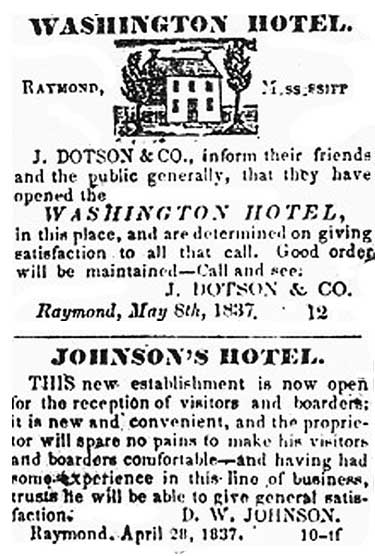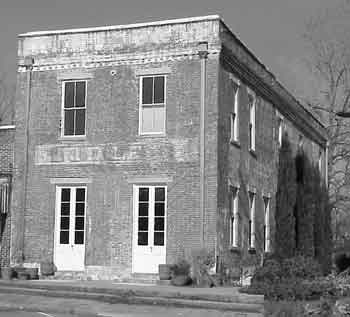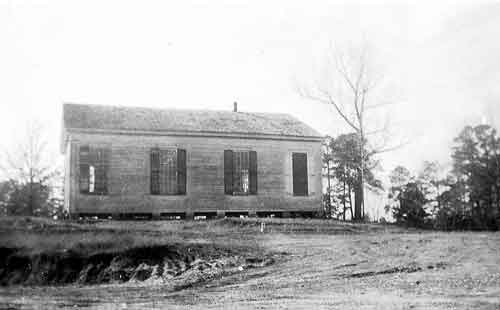"Raymond Years Ago"
By George W. Harper
Journalist - Editor - Owner Of Hinds County Gazette 1845-1883
A Series Published in the Hinds County Gazette, 1878-1879
From the Gillespie Collections edited by Pattie Adams Snowball and Rebecca Blackwell Drake
Home Page
Harper Arrives in Mississippi
Vicksburg & Meridian RR
Businesses in 1844
The Raymond Bar
Early Merchants
1844 Businesses
Seat of Justice
Cotton Industry
Early Churches
Establishment of Schools
John B. Peyton
Raymond Area Homes
Medicinal Resorts & Spas
The Mexican War
Early Churches
Early Schools
Raymond Female Institute
Raymond Military Institute
McNutt-Foote Debate
1844 Presidential Election
Local Elections of 1845
Literary Raymond
Raymond Fires
Old Log Jail
Death of Jos. Stewart
Murder of Benj. Sims
Duel Ends in Death
Raymond & Bolton RR
Harper Elected Mayor
Chaos at Oak Tree Hotel
Great Fire of 1858
Early Area Settlements
-
Amsterdam
-
Yeizer's Store
-
Newtown
-
Meridian Springs
-
Sturgiss Store
-
Dry Grove
-
County Line
Rev. Fisk's Biology Class
Fisk Charged with Fraud
Fleetwood Tragedy
Local Racetracks
Dignitaries Visit Raymond
Winning the Lottery
Fire Company No. 1
"Devoted & Valued Friend"
Tribute to Amos Johnson
Yellow Fever Strikes Raymond
Doctors Treating Victims
Cooper's Well
Mississippi Springs
Newspaper Entrepreneurs
Yankees Sack Gazette Office
Fate of Editorial Giants
Henry Clay Defeated in 1844
Stray Cats in Raymond
"A Remarkable Occurrence"
Blow That Punky Bell to Hell"
Isom Bldgs Destroyed
1851 Gubernatorial Election
Union Ticket Sweeps State
New Raymond Courthouse
Gibbs Building Rebuilt
Hinds Co. Poor House
Schools Struggle
Murder of Addie Owens
War comes to Raymond
The Battle of Raymond
Willie Foote Captured
Make-shift Hospitals
Yankees Occupy Raymond
Raymond Lodge No. 21
Odd-Fellows' Graveyard
Bolls Incarceration
Crimes Blamed on Whisky
Peyton's Willow Tree Prank
Politics in Raymond
Presidential Election 1860
Hinds Co. for Succession
Raymond Fencibles Organized
Churches Reorganize
The Clinton Riot of 1875
Why the Great Uneasiness?
Deaths of Sivley & Thomson
"Kill the Raymond Men"
Harrison Election
Political Gatherings
Event at Dupree's Grove
Presidential Election 1876
Governor Ames Impeached
Great Wrongs Investigated
Fight the Devil with Fire
Reconstruction Era
Harper Ends with Poetic Vision
Part II
Businesses in Raymond: 1844
In 1844 there was a one-story frame building where Dr. J.
M. Bogle’s drug store now stands, which was occupied by Mark Mason as a drinking
saloon and billiard room.  Mark also had a livery stable about where Bogin Jones’
house now stands. He also planted quite
extensively a mile or two west of the town. He left Raymond, quite poor, about 1850, for California. About the same
time the old Dotson hotel property stood on the now vacant corner of the public
square. It had pretty well gone to decay, but there was a drinking salon there,
and also a billiard table and ten-pin alley. The Oak Tree Hotel was kept by Mrs.
Caroline Robinson, and then had the spacious wing running southward, which has
since been removed. Then, as for years afterwards, the corner room of the main
building was used as a bar-room, with a billiard and ball room attached.
Mark also had a livery stable about where Bogin Jones’
house now stands. He also planted quite
extensively a mile or two west of the town. He left Raymond, quite poor, about 1850, for California. About the same
time the old Dotson hotel property stood on the now vacant corner of the public
square. It had pretty well gone to decay, but there was a drinking salon there,
and also a billiard table and ten-pin alley. The Oak Tree Hotel was kept by Mrs.
Caroline Robinson, and then had the spacious wing running southward, which has
since been removed. Then, as for years afterwards, the corner room of the main
building was used as a bar-room, with a billiard and ball room attached.
The post office was the kept by D. Peyton Harrison, in the west room of Professional Row [see note], Mr. Harrison residing with his family in a house where Dr. Latimer’s residence now stands. The second room in Professional Row, was occupied by Dr. N. W. Vallandigham; the third by Deavenport & Graves, as a law office, and the fourth by some of the young men of the town as a Bachelor’s Hall. [see note]
Raymond: The Seat of Justice
|
The Probate Court was then held on the first Monday of every month. The court was held and the Probate office kept in the second story of the building now occupied by Col. Charlton as a store. In the first story was the Circuit clerk’s office, but the Circuit court was held of course in the Court-house.
The building in which these offices were kept then belonged to the county, and remained county property until about 1859. G. B. Downing was then deputy in the circuit Clerk’s office; W. H. Hampton and Jos. Bond, deputies in the Probate office; and J. B. Fairchild deputy in the Sheriff’s office. They were all splendid officers, and more gentlemanly, accommodating and faithful public servants never lived.
A few days after our arrival in Raymond, and in the court house yard, a man from Alabama, named Ball, was shot and killed by a citizen of the county. Ball was the first man killed in the town. The citizen who unfortunately committed the act was arrested, committed, and afterwards tried and acquitted. About the same time a street fight occurred between two of the young lawyers of the place. Shots were exchanged, but friends interposed and stopped the affair.
A man from Warren county was tried for murder in Raymond about this time by change of venue. John I. Guion, W. A. Lake, Pat W. Tompkins, H. S. Foote and other lions of the day were engaged in the cause, and the old court house fairly rung with their eloquence. The accused party was acquitted, Geo. Coalter, or “old ramsowser” as he was generally called,) was the circuit Judge, and he had just rendered himself quite conspicuous by fining and sending to jail two or three Vicksburg Editors for commenting too freely on some of his decisions.
The Cotton Industry in Raymond
The New Orleans and Jackson R.R. was not then built, or thought of, and there were no such towns as Terry, Byram and Crystal Springs. Much of the cotton and trade that now go to those points then came to Raymond, and it was a highly profitable trade. And then, again, there was not a store at Bolton, and but one very small retail establishment at Edwards. The trade in all this part of the county was then done directly with Raymond, Vicksburg or New Orleans, which gave Raymond an importance of which it has been considerably shown in later days by the capital, vim and enterprise of the new towns named.
In 1844 it was the custom for the white people of the entire neighborhood (embracing an area of ten miles or more,) to come to town every Monday. And on Probate and Circuit court days almost every white man in the county, apparently, was here. There was much more town visiting then, than now, and the traveling was all done on horse-back—no buggies no carriages, and but little use for the railroad. The buggies, carriages, & Co., did not come in until about 1850, the period when the people commenced going in debt and acquiring the fondness for display.
Cotton sold in the streets of Raymond in 1844 at 5 cents per pound. The producers were doing pretty well for they were paying expenses and saving something for “a rainy day.” But the price was deemed too low, and there was a strong effort made to organize the planters into a society with the object of reducing the volume of the crop—the low price being attributed alone to the over-production. It was proposed, in high quarter, that no planter should make more than three bales to the hand, (whereas they were then making from 8 to 15, with all necessary home supplies besides.) The proposition, however, broke down—while those who raised an abundance of peas, potatoes, corn, meat, &c., and did not indulge too heavily in whisky, buggies, carriages, store clothes and imported luxuries and nonsense, became rich; while those who cultivated cotton only, and bought everything else, with but few exceptions came out poor.
Early Churches at Raymond and Palestine
|
|
As we have before said, there was preaching but twice a month in Raymond, in 1844, and that was in the Methodist church, by Rev. P. Cooper. On, intervening Sundays, however there was preaching at Palestine, by Elder Samuel Thigpen, a Baptist clergyman and a gentleman of high repute and unquestioned piety. It was the custom on the intervening Sunday, for all the Raymondites who could raise horses, to go to Palestine and hear Bro. Sam Thigpen. Wiggins Biggs, Zachariah Holliday, Wm. Edmonson and others who were then the ruling spirits there, all of whom have passed away to the better hand save Wm. Edmonson, who still lingers on the shores of time on the same old plantation.
|
Palestine Baptist Church located in the |
We went to Palestine for the first time on a bright Sunday morning in 1845, with the crowd. It was a very warm, dry day, and there was one thing the attracted our attention above all the other things, and it was this. A bucket of water was kept in the church on the edge of the pulpit, and during the singing, praying and preaching, there was a constant run from the congregation to the water bucket. The women and children were the principal patrons of the bucket, but there were instances of full grown men going forward and helping themselves. And this went on every few minutes during the service, (an aged colored man replenishing the supply when the bucket became exhausted,) and yet the minister did not check it, nor did it, to all appearances, annoy him in the least.
 We had never before witnessed such a scene during the preaching of the
gospel and hence the water bucket spectacle was about all we saw or heard on our
first visit to Palestine. We now often hear the residents of the Palestine
neighborhood complain that this present generation will not compare with the
generation of 1844 in any of the attributes of manhood and true womanhood. How
this may be, we do not pretend to say, but we can confidently assert that the
water privileges, in the church edifice, are not now indulged in. An ample
supply can be found, however, at no inconvenient distance.
We had never before witnessed such a scene during the preaching of the
gospel and hence the water bucket spectacle was about all we saw or heard on our
first visit to Palestine. We now often hear the residents of the Palestine
neighborhood complain that this present generation will not compare with the
generation of 1844 in any of the attributes of manhood and true womanhood. How
this may be, we do not pretend to say, but we can confidently assert that the
water privileges, in the church edifice, are not now indulged in. An ample
supply can be found, however, at no inconvenient distance.
Notes - - Mr. F. A. R. Wharton informs us that we were wrong in placing the postoffice in Professional Row in 1844. He reminds us that there was a small one-story frame building between the Shearer building and Professional Row, (long ago removed,) and that it was in the small frame house that D. Peyton Harrison kept the postoffice.
In our list of merchants in the town in 1844, given in a former number, we accidentally omitted the name of C. Vanderpool. Mr. Vanderpool remained in Raymond until 1854 or ’55, when he removed to Sunflower Landing. If still living, we are not advised as to his place of residence.
All photographs, drawings and illustrations were edited into the series by Pattie Snowball and Rebecca Drake.
Copyright © 2008 Pattie Adams Snowball, James and Rebecca Drake


